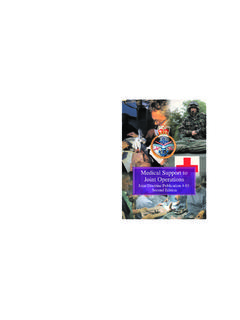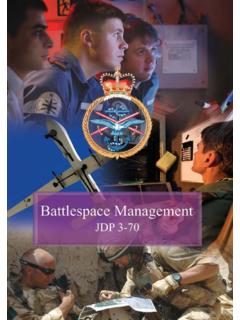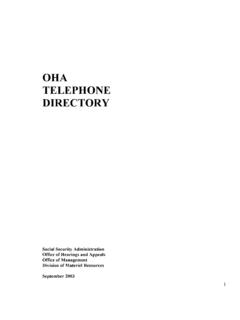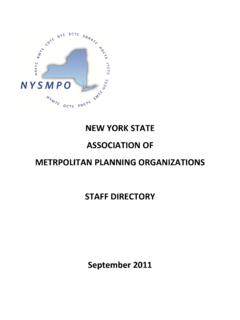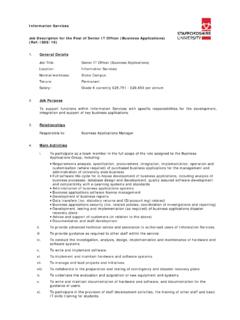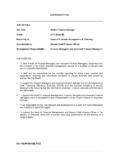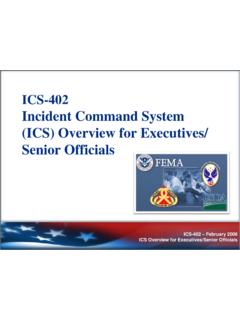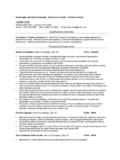Transcription of A Primer for Senior Leaders
1 The Joint Training System A Primer for Senior Leaders CJCS Guide 3501 10 October 2003 (INTENTIONALLY BLANK) CJCS Guide 3501 "The Joint Training System: A Primer for Senior Leaders " FOREWORD Commanders at all echelons are responsible for preparing their commands to accomplish assigned missions. To be successful we must train our forces, first and foremost, on warfighting. We must train the way we intend to fight. These forces must also be ready to successfully conduct military operations other than war (MOOTW) and operate in the interagency and multi-national environment. It is every commander s business to be trained and ready. In order to plan and execute meaningful, effective training, they need focused guidance from joint force commanders.
2 This handbook is designed for joint force commanders and other Senior Leaders . It provides an overview of the Joint Training System (JTS) and highlights the role of our Senior leadership in the execution of joint training. I strongly recommend reading this Primer ; it summarizes my guidance and the processes required to execute the JTS that are laid out in detail in several CJCS instructions and manuals on joint training. The foundation of a commander s training guidance to staff and subordinates is the JTS; that guidance assures focused, effective joint training. Read, learn, and apply. Effective joint training is the key to effective joint warfare. RICHARD B. MYERS Chairman of the Joint Chiefs of Staff (INTENTIONALLY BLANK) CJCS Guide 3501 supersedes the 1998 iteration of the JTS Primer .
3 It was prepared and updated by US Joint Forces Command in coordination with the Joint Staff. The JTS Primer reflects the guiding principles of the JTS and its components. Joint Warfighting Center, Suffolk, VA This publication is approved for public release; distribution is unlimited. DOD components (to include the combatant commands), other federal agencies, and the public may obtain copies of this manual through the Internet from the CJCS Directives Home Page -- Copies are also available through the Government Printing Office on the Joint Electronic Library CD-ROM. (INTENTIONALLY BLANK)JTS Primer CJCSG 3501 i Table of Contents Chapter 1 - 1 Chapter 2 - Goals and 5 Figure II 1. Joint Training System Vision .. 5 Chapter 3 - Key Reference 9 Figure III 1.
4 Key Documents Supporting Joint Training .. 9 Figure III 2. Master Training 10 Chapter 4 - Joint Training 15 Figure IV 1. The Joint Training System .. 16 Figure IV 2. Sample Entry from a JMETL .. 17 Figure IV 3. Requirements Phase .. 18 Figure IV 4. Combatant Commander s Joint Training Plan .. 19 Figure IV 5. Combat Support Agencies and Joint Organizations .. 20 Figure IV 6. Plans 21 Figure IV 7. Joint Event Life 22 Figure IV 8. Execution Phase .. 23 Chapter 5 - Joint Lessons Learned Program (JLLP).. 25 Figure V 1. JLLP Process .. 25 Figure V 2. Remedial Action Program .. 26 Figure V 3. JCLL Crest .. 27 Chapter 6 JTIMS - Joint Training Information Management 29 Figure VI 1 JTIMS .. 30 Chapter 7 - 31 Figure VII 1. Joint Training System 31 Figure VII 2. Commander s Commitments .. 32 JTS Primer CJCSG 3501 ii (INTENTIONALLY BLANK)JTS Primer CJCSG 3501 1 Chapter 1 - Introduction This Primer is designed to help combatant commanders, subordinate joint force commanders, functional or Service component commanders, and other Senior officers understand the value and importance of the Joint Training System (JTS).
5 More importantly, it will underline their role in using that system to train their forces to accomplish assigned missions. Definition of the JTS. The JTS is a framework used by the joint community to: identify training requirements; develop training plans; and execute, evaluate, and assess joint training events. (Joint Training Policy CJCSI , Page V.) Importance of the JTS. The Joint Training System is your training system. In broad terms, the JTS is designed to ensure the Armed Forces of the United States are trained and prepared to promote peace and stability and to defeat adversaries. More specifically, it provides an integrated, requirements-based method for aligning training programs with assigned missions consistent with command priorities, capabilities, and available resources.
6 The Joint Training Information System (JTIMS) provides automation support for the JTS. The JTS should be applied by commanders with these five basic tenets as guiding principles: Focus on the warfighting mission it is the most dangerous and likely mission tasked by the Joint Strategic Capabilities Plan (JSCP). Train the way you intend to fight training events, particularly exercise training events, should reflect realistic conditions. JTS Components: Identify requirements, develop plans, execute, evaluate and assess joint training events JTS aligns training with assigned mission The teams and staffs through which the modern commander absorbs information and exercises his authority must be a beautifully interlocked, smooth working mechanism. Ideally, the whole should be practically a single mind.
7 General Dwight D. EisenhowerSupreme Commander, Allied Forces, World War IIJTS Primer CJCSG 3501 2 Commanders are the primary trainers they are responsible at all echelons for preparing their forces to accomplish their mission. Apply joint doctrine it establishes fundamentals of joint operations and provides guidance on how to employ forces to achieve assigned objectives. Centralize planning; decentralize execution of training, just as would be done in real operations. JTS in Perspective. Military training has evolved with the nature of the strategic environment. The case can be made that US and allied forces fought jointly during WWII. They did so out of necessity in order to bring the greatest amount of force to the enemy in the most efficient manner possible.
8 Training to fight jointly, however, did not come to fruition until the 1980s. Following the Operation DESERT STORM s after action review (AAR), the Joint Chiefs of Staff determined the need to institutionalize a mission-to-task (requirements-based) training system. CJCS findings brought about a master plan that has evolved from events-based training to requirements-based training and is embodied in the four-phase JTS. The JTS was initiated in FY 1994 for the purpose of linking Joint Mission Essential Tasks (JMETs) to readiness. Commander's Commitments. As a commander, what are your responsibilities within the JTS and where can command emphasis be placed with best results? The following commitments identify those areas where commanders have specific responsibilities: Designate staff responsible for joint training and ensure they use the JTS.
9 Geographic Combatant Commanders develop The Joint Training System is based on mission-to-task training Develop Command JMETL Assign Staff Responsibilities JTS Primer CJCSG 3501 3their Joint Mission Essential Task List (JMETL), and distribute to supporting combatant commanders, Service component commands, combat support agencies, and the Joint Staff annually in October via JTIMS. Ensure JMETL is linked to plans and exercises and is cross walked with components. The JMETL for USEUCOM, USCENTCOM, USSOUTHCOM, USNORTHCOM, and USPACOM are due 15 October. Provide commanders guidance to promulgate your Joint Training Plan to component commanders and joint staff. Geographic Combatant Commanders, publish and distribute joint training plans (JTP) and joint training schedules, (including the JMETL developed in October), in March to supporting combatant commanders, Service component commands, combat support agencies, and Joint Staff via JTIMS.
10 The JTPs for USEUCOM, USCENTCOM, USSOUTHCOM, USNORTHCOM, and USPACOM are due 15 March. Functional Combatant Commanders, publish and distribute JTPs and joint training schedules in May to combatant commanders, Service component commands, combat support agencies, and Joint Staff via JTIMS. The Joint Training Plans for USJFCOM, USTRANSCOM, USSTRATCOM, USSOCOM, and NORAD are due 15 May. Combat Support Agencies publish and distribute agency training plans (ATP) including agency mission essential task list (AMETL) in July to combatant commanders, Service component commands, combat support agencies, and Joint Staff via JTIMS. The Agency Training Plans for DIA, DISA, DLA, DTRA, DCMA, NIMA, and NSA/CSS are due 15 July. Approve Joint Training Plans Provide Guidance JTS Primer CJCSG 3501 4 Consider resources available to meet joint training requirements.
